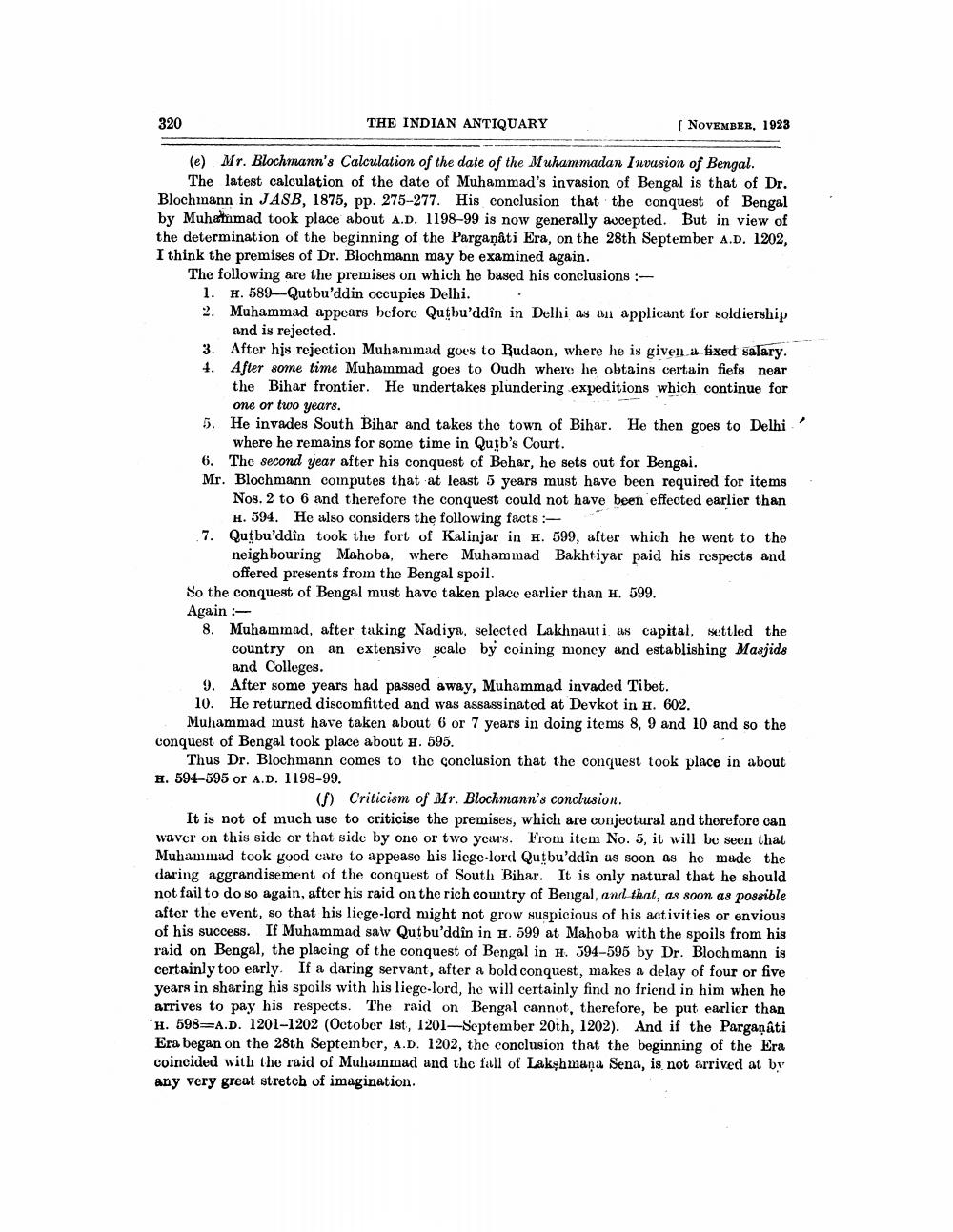________________
THE INDIAN ANTIQUARY
(e) Mr. Blochmann's Calculation of the date of the Muhammadan Invasion of Bengal. The latest calculation of the date of Muhammad's invasion of Bengal is that of Dr. Blochmann in JASB, 1875, pp. 275-277. His conclusion that the conquest of Bengal by Muhammad took place about A.D. 1198-99 is now generally accepted. But in view of the determination of the beginning of the Parganâti Era, on the 28th September A.D. 1202, I think the premises of Dr. Blochmann may be examined again.
The following are the premises on which he based his conclusions:
320
[NOVEMBER, 1923
1.
H. 589-Qutbu'ddin occupies Delhi.
2. Muhammad appears before Qutbu'ddîn in Delhi as an applicant for soldiership and is rejected.
3. After his rejection Muhammad goes to Rudaon, where he is given a fixed salary. 4. After some time Muhammad goes to Oudh where he obtains certain fiefs near the Bihar frontier. He undertakes plundering expeditions which continue for one or two years.
5. He invades South Bihar and takes the town of Bihar. He then goes to Delhi where he remains for some time in Qutb's Court.
6. The second year after his conquest of Behar, he sets out for Bengai.
Mr. Blochmann computes that at least 5 years must have been required for items Nos. 2 to 6 and therefore the conquest could not have been effected earlier than H. 594. He also considers the following facts:
7. Qutbu'ddîn took the fort of Kalinjar in H. 599, after which he went to the neighbouring Mahoba, where Muhammad Bakhtiyar paid his respects and offered presents from the Bengal spoil.
So the conquest of Bengal must have taken place earlier than H. 599.
Again :
8. Muhammad, after taking Nadiya, selected Lakhnauti as capital, settled the country on an extensive scale by coining money and establishing Masjids and Colleges.
9. After some years had passed away, Muhammad invaded Tibet.
10. He returned discomfitted and was assassinated at Devkot in H. 602. Muhammad must have taken about 6 or 7 years in doing items 8, 9 and 10 and so the conquest of Bengal took place about H. 595.
Thus Dr. Blochmann comes to the conclusion that the conquest took place in about
H. 594-595 or A.D. 1198-99.
(f) Criticism of Mr. Blochmann's conclusion.
It is not of much use to criticise the premises, which are conjectural and therefore can waver on this side or that side by one or two years. From item No. 5, it will be seen that Muhammad took good care to appease his liege-lord Qutbu'ddîn as soon as he made the daring aggrandisement of the conquest of South Bihar. It is only natural that he should not fail to do so again, after his raid on the rich country of Bengal, and that, as soon as possible after the event, so that his liege-lord might not grow suspicious of his activities or envious of his success. If Muhammad saw Qutbu'ddîn in H. 599 at Mahoba with the spoils from his raid on Bengal, the placing of the conquest of Bengal in H. 594-595 by Dr. Blochmann is certainly too early. If a daring servant, after a bold conquest, makes a delay of four or five years in sharing his spoils with his liege-lord, he will certainly find no friend in him when he arrives to pay his respects. The raid on Bengal cannot, therefore, be put earlier than H. 598 A.D. 1201-1202 (October 1st, 1201-September 20th, 1202). And if the Parganâti Era began on the 28th September, A.D. 1202, the conclusion that the beginning of the Era coincided with the raid of Muhammad and the fall of Lakshmana Sena, is not arrived at by any very great stretch of imagination.




